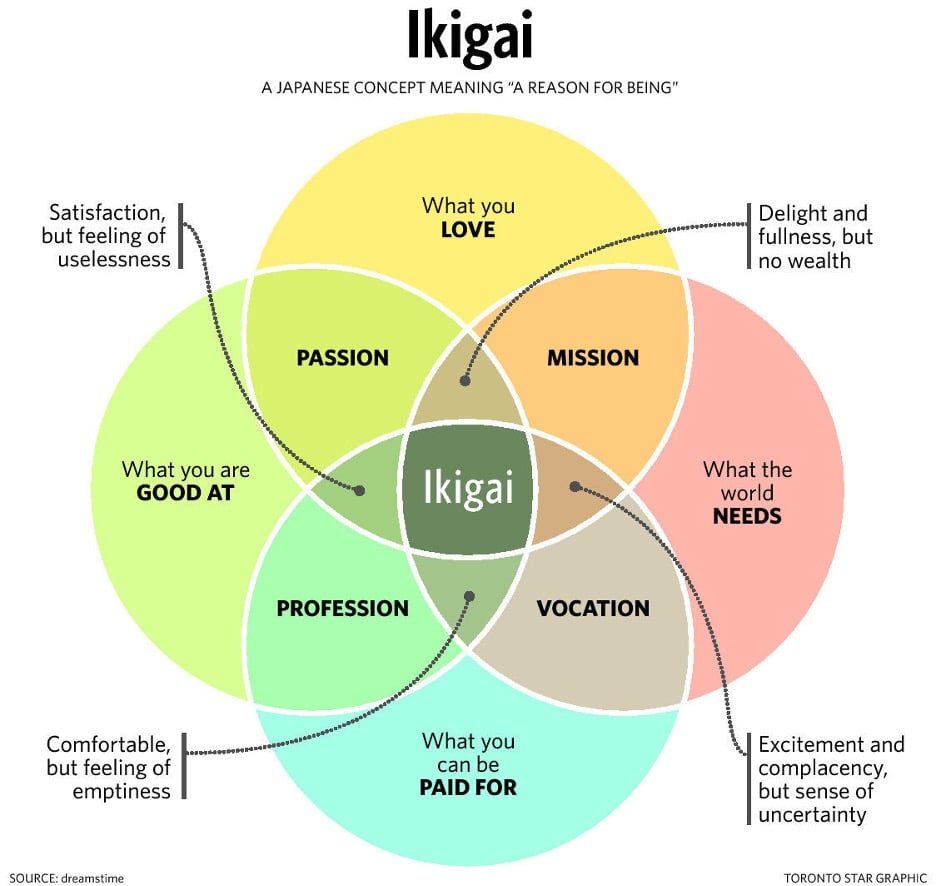What is beyond mission and vision? Ikigai
Has your vision statement run its course?
Ikigai, which loosely translates to "a reason for being," resides at the confluence of four primary elements: passion (what one loves), vocation (what one is good at), mission (what the world needs), and profession (what one can be paid for). The beauty of Ikigai lies in its simplicity and depth, offering a holistic approach to fulfilment that balances internal desires with external demands. For individuals, Ikigai is a journey of self-discovery and alignment, encouraging a life lived with intention and joy. However, the application of Ikigai need not be limited to the individual.
What if we were to imagine an organisation as a human being and then apply the concept of Ikigai to it? Can organisations, with their myriad complexities and external pressures, find a similar path to fulfilment and purpose?
Core elements of organisational Ikigai
In the quest to apply the concept of Ikigai to an organisation, understanding its core elements is essential. Ikigai, a Japanese term that loosely translates to "a reason for being," integrates four fundamental components: what you love, what you are good at, what the world needs, and what you can be paid for. When these elements converge, they create a powerful sense of purpose, direction, and fulfilment. For organisations, aligning these elements can lead to unparalleled success, innovation, and positive impact.

For a board this means a willingness of directors to question deeply held beliefs and assumptions, to listen to diverse voices within and outside the organisation, and to embrace uncertainty and ambiguity. This process of self-discovery for Boards is not a linear path but a cyclical journey of reflection, learning, and adaptation, mirroring the continuous evolution of the organisation's identity and the board’s approach to strategy.
What the organisation loves: passion
The first element of Ikigai revolves around passion. For an organisation, passion is derived from its core values, vision, and the intrinsic motivations that drive its existence beyond profit. It's about identifying what the organisation stands for, its commitment to certain causes or ideals, and the enthusiasm it shares for its work. This passion is the lifeblood that energises employees, attracts customers, and differentiates the organisation in the market.
To do: Cultivate an environment that encourages exploration, creativity, and a strong sense of belonging. Leadership plays a crucial role in articulating and embodying this passion, inspiring it through their actions and decisions, and embedding it into the organisational culture.
.png?width=500&height=262&name=Article_Board%20choice%20(10).png)
What the organisation is good at: vocation
The second element focuses on the organisation's vocation, which involves recognising and leveraging its strengths and core competencies. It's about understanding what the organisation excels at, the unique skills and expertise it brings to the table, and how these can be honed and expanded. This requires a deep dive into the organisation's processes, products, services, and employee talents, identifying areas of excellence and differentiation. A commitment to continuous learning, innovation, and improvement is key to developing and maintaining these strengths.
To do: Foster a culture of excellence by investing in employee development, encouraging knowledge sharing, and embracing challenges as opportunities for growth.
.png?width=500&height=262&name=Article_Board%20choice%20(11).png)
What the world needs: mission
The third element, the mission, connects the organisation to the broader context in which it operates. It addresses the question of what the world needs and how the organisation can meet these needs through its products, services, or initiatives. This is where the organisation's purpose intersects with societal or environmental challenges, offering a path to meaningful impact. Identifying and aligning with these needs requires empathy, awareness, and a commitment to sustainability and ethical practices.
To do: Engage with communities, stakeholders, and partners to understand these needs better and innovate solutions that contribute positively to society and the environment.
.png?width=500&height=262&name=Article_Board%20choice%20(8).png)
What you can be paid for: profession
The fourth and final element of Ikigai is the profession, which relates to the organisation's economic sustainability. It's about ensuring that the organisation's passions, strengths, and mission are channelled into viable business models that generate revenue and profitability.
To do: Undertake strategic planning, market analysis, and business case development to identify opportunities for growth, diversification, and value creation. Balancing financial goals with the other elements of Ikigai is crucial, as it ensures that the organisation remains financially healthy while staying true to its purpose and values.
.png?width=500&height=262&name=Article_Board%20choice%20(9).png)
The magic of Ikigai lies in the convergence of these four elements. For organisations, finding this sweet spot means achieving a balance where their work is not only financially rewarding but also deeply fulfilling, impactful, and aligned with their core competencies. Navigating this convergence requires a holistic approach, integrating strategic planning with a deep understanding of the organisation's identity and the external environment. It involves making tough choices, prioritising initiatives that align with the Ikigai framework, and being willing to pivot or reinvent aspects of the organisation that do not contribute to this alignment.
Implementing organisational Ikigai
Implementing organisational Ikigai can be broken down into 5 stages:
1. The first stage towards implementing Ikigai within an organisation involves a deep understanding of its four core elements—what the organisation loves doing, what it is good at, what the world needs, and what it can be paid for—and how these elements intersect to reveal the organisation's true purpose. This requires a thorough assessment process, engaging various stakeholders within and outside the organisation. This understanding requires introspection and dialogue among all levels of the organisation, from top leadership to entry-level employees. Organisations can facilitate workshops, surveys, and open forums to capture a comprehensive view of their collective strengths, passions, market opportunities, and societal contributions. Leaders should initiate dialogues to capture diverse perspectives, employing tools such as SWOT (Strengths, Weaknesses, Opportunities, Threats) analysis, employee surveys, customer feedback, and market research.
2. The next stage in implementing organisational Ikigai is the articulation of a clear, compelling vision and mission that resonate with the organisation's Ikigai and in crafting narratives that connect the organisation's day-to-day activities with its broader purpose. This involves refining the organisation's purpose and goals to reflect a balance between its passions, the needs of the world, its competencies, and the avenues for sustainable revenue. Leaders play a pivotal role in shaping and communicating the organisation's identity. Through their vision, values, and actions, leaders influence the culture, priorities, and strategic direction of the organisation. They are the custodians of the organisation's purpose, tasked with guiding it through the complexities of finding and living its Ikigai. Effective leaders understand the importance of aligning the organisation's internal strengths and passions with external opportunities and challenges, creating a cohesive narrative that resonates with all stakeholders. This narrative becomes a guiding light, informing decision-making, strategy development, and cultural practices.
3. With a clear vision and mission in place, the next stage is to align the organisation's strategy and operations with its Ikigai. This alignment is crucial for ensuring that the pursuit of Ikigai is not just an abstract concept but a practical guide for decision-making and strategy development This requires a holistic approach, integrating Ikigai principles into all aspects of the organisation, from product development and marketing to HR practices and customer engagement. It involves reevaluating existing processes, structures, and metrics to ensure they support the organisation's purpose and goals. Strategic initiatives may include innovation in product or service offerings that better meet societal needs, restructuring teams to leverage strengths more effectively, and developing new business models that align with the organisation's values and market opportunities.
4. An Ikigai-driven culture is fundamental to sustaining the organisation's purpose and values over the long term. This culture promotes engagement, creativity, and resilience, empowering employees to contribute their best work. The next stage is thus to build such a culture through deliberate efforts to embed Ikigai principles into everyday practices. Leaders should model the behaviours and attitudes that reflect the organisation's Ikigai, fostering an environment where open communication, collaboration, and continuous learning are valued. Encouraging employee involvement in decision-making and initiative development can also reinforce a sense of ownership and commitment to the organisation's purpose. This involves implementing policies and practices that support work-life balance, continuous learning, and career development, as well as creating spaces for innovation, creativity, and social impact initiatives. Leaders play a crucial role in modelling Ikigai principles, demonstrating through their actions the importance of passion, mission, vocation, and profession in achieving personal and organisational success.
5. Implementing organisational Ikigai is an ongoing process, the final stage is thus one of regular monitoring, evaluation, and adaptation. Developing metrics and indicators that capture both the tangible and intangible aspects of the organisation's impact is essential. These might include traditional financial metrics, as well as measures of employee satisfaction, customer loyalty, social and environmental impact, and innovation. Regularly reviewing these indicators helps organisations understand their progress towards their Ikigai, identifying areas of success and opportunities for improvement. It also enables them to communicate their impact to stakeholders, building trust and support for their mission.
As organisations increasingly seek to find meaning and purpose in their operations, the concept of Ikigai offers a promising path forward. Implementing organisational Ikigai not only enhances the organisation's ability to achieve sustainable success but also contributes to the well-being of its employees, customers, and the broader society. The journey towards organisational Ikigai is both challenging and rewarding, requiring a deep commitment to exploration, learning, and growth. By embracing this journey, organisations can unlock new potentials, innovate in response to the world's changing needs, and create a legacy of positive impact that transcends generations. The implementation of organisational Ikigai is not just a strategy for success but a commitment to a deeper sense of purpose and responsibility in the business world.
When you're ready here's how BoardPro can help
Start a Free Trial — run a whole board meeting cycle for free, no credit card needed. You’ll be able to create board packs in a click, and have all minutes, decisions, actions and interests in one place. Be more effective, save time, and have everyone on the same page! Book a Demo — see BoardPro in action in this 30-minute demo, and have all your questions answered by a BoardPro specialist. You’ll get an introduction to all of BoardPro’s features — see how to set an agenda, create board packs, and take minutes. Attend a Free Governance Webinar — learn from our community of governance experts on subjects such as strategy, understanding board dynamics, reporting, and running effective meetings. You’ll join hundreds of others in these engaging events covering the latest governance topics. Find a Governance Template — practical documents to make governance easy! Templates cover strategic planning, board evaluation, risk assessment, SWOT analysis, and many other essential governance and business topics to grow your organisation and adopt good governance practices. |
Share this
You May Also Like
These Related Stories

Understanding board dynamics

How can boards be intentional about DEI?


